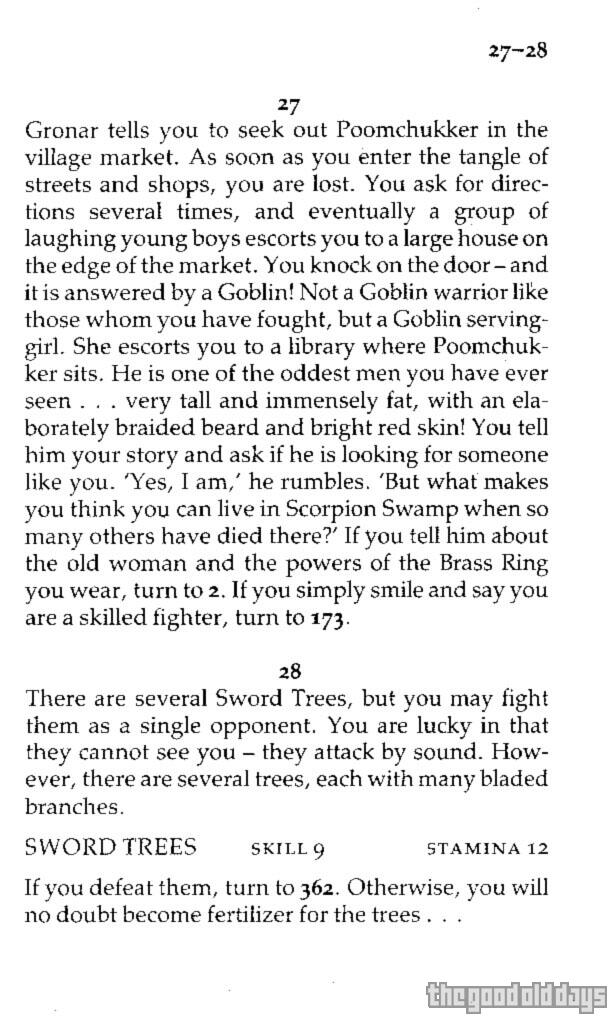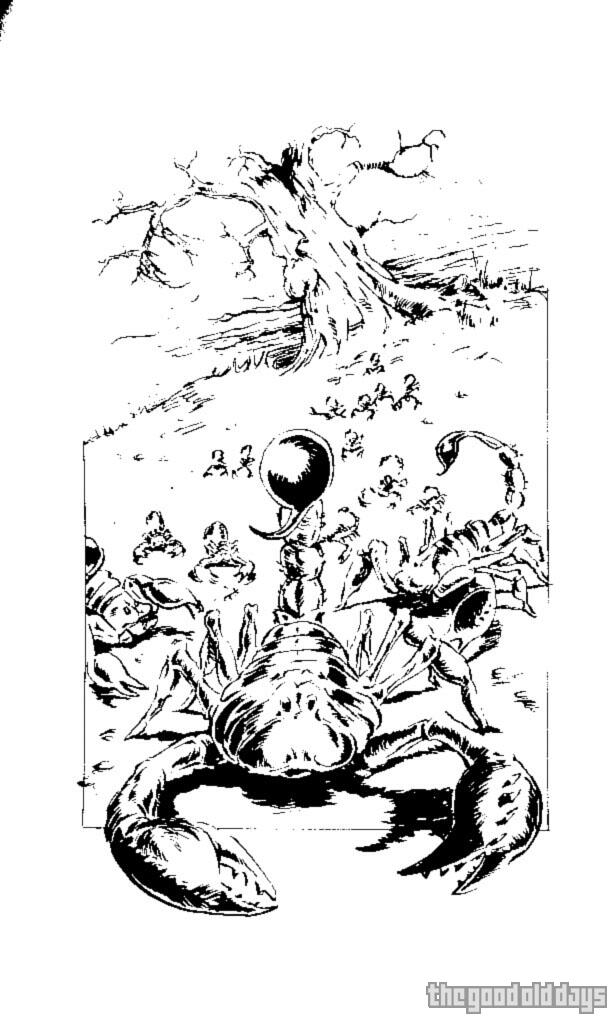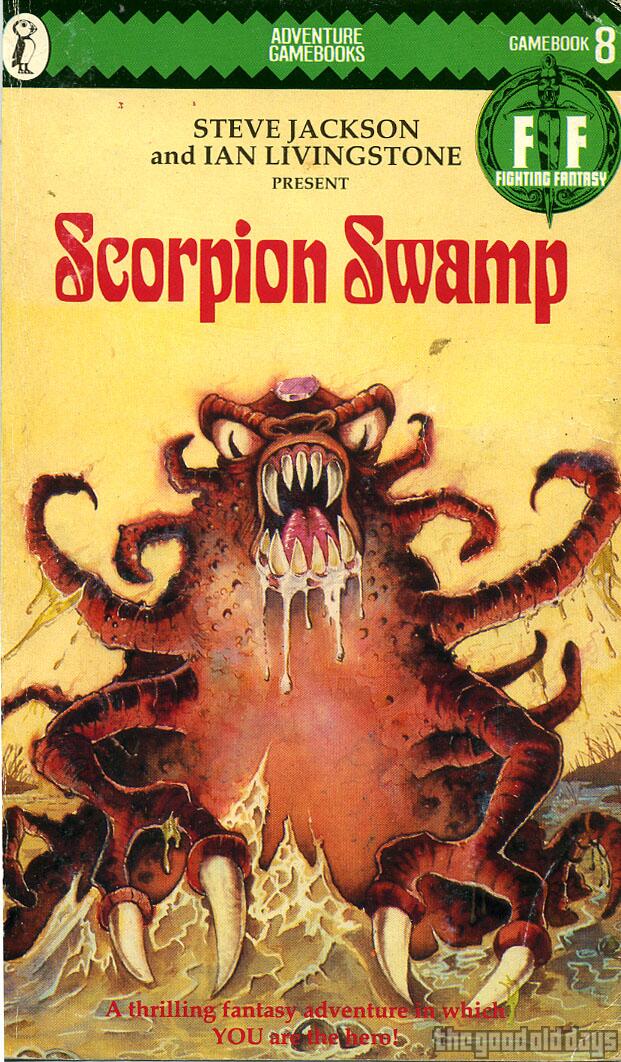Thoughts by Mr Creosote (02 00 2023) – Gamebook
The first Fighting Fantasy book written by someone else than the Games Workshop founders duo. The honour went to… drumroll… Steve Jackson. Yes, I know. It was not even acknowledged on the book cover or inside that this was another Steve Jackson. Which today, thanks to the Internet, we have finally learned. Although looking at the book’s contents, it might as well have been devised by the first Steve Jackson, given how structurally experimental it is. On a number of points.
The first one being that it doesn’t contain one, but three stories. One of the initial decisions in the book is to accept one of three missions. Each of them leads to the eponymous swamp, but tasked to retrieve or achieve different things. One mission given by a good wizard, one by an obviously evil one and one “neutral”. Just as it has to be in a D&D-like scenario.

Second, the book allows free movement throughout its world. Not just in an intentionally cryptic maze, like in the first book, but everywhere. Which is handled quite gracefully by the book offering two different states of each location: the initial and the “already visited” one.
The ideas and the craft behind it are fascinating. The book’s paragraphs essentially just define the world in which those different adventures can be experienced. The same locations, the same encounters taking different meanings depending on the player’s objective. Depending on the mission, the Master of the Wolves could be a helpful advisor or a target to be eliminated. Replayability being an option even after having succeeded. In turn, this makes it unnecessary for the author to put in loads of death traps or all too deadly fights which the player is supposed to fail, just so that there are opportunities to start over and thus increase play time.
It is just that indeed, the total number of paragraphs remains the usual one, 400. The same amount which in other books of the line is used to flesh out a single story. Here, there are three plots crammed inside the same space. Some encounters and places being relevant for more than one mission, but some definitely not. Reducing the latter to random, meaningless encounters when on another plotline.
This, by itself, is not too bad. After all, all of the other books also feature a large number of sections which are finally just fluffy fillers. There is, however, something else reducing the number of paragraphs where something can effectively happen, even. It is the concept of free movement, forcing the author to waste numerous paragraphs for pure bookkeeping.
To illustrate, when entering one of the numbered clearings, there is one “initial state” encounter. For instance, you might see a dwarf fighting a giant scorpion. If you’ve been there previously, that fight will be over, and a second section is used to just tell you that there is nothing special there. If you choose to run away from the fight the first time, there will be another section instructing you that you can only run back to where you came from. Sending you to yet another section listing those directions. Meaning out of the four sections mentioned, three a there only to manage the free movement scheme, adding absolutely nothing in terms of plot or gameplay.

On top, experience from previous playthroughs makes a fair number of locations into annoying chores to go through. The first time around, the sword trees or the fear grass might be considered exciting. Though you need to pass them more than once per adventure. The third time, you will have exhausted all possibilities anyway, so another time feels rather unnecessary than entertaining.
For sure, nevertheless, there is something to be said for “short and sweet” adventures like these, which can be solved in one sitting. In principle, there is even a difficulty progression between them. The one suggested by the book, the “good” path, being the easiest, and the “evil” one the hardest. In what way is the latter harder? Just by throwing in two or three really tough enemies to fight. Pity, the least interesting manner to achieve that.
And, unfortunately, that not very interesting manner also accounts for the three plotlines themselves. The setting of the mysterious swamp where no compass will work and about which nobody knows what will be found there could be a fascinating one. Though when actually there, the locations turn out very generic.
The quests are quite generic, too. The good wizard asks for a rare plant, the evil one wants the magical amulets worn by his rivals. The neutral one just wants you to get to the city on the other side. Of those, the second one cannot be considered a thematic fit with the setting. The first and the third one could have been reflected in this regard, but they essentially only come down to finding the right location where the quest object/target is found. In case of the third quest, it is not even clear how the map the player delivers at its end will really serve the employer’s needs considering the magical specialties of the swamp which should throw the caravans off course anyway. Oh, wait, those existed only in the introductory text.
The structural experiment is an interesting one for sure. There are several signs of this originally having been intended to be the beginning of a campaign of interconnected books even. Most strikingly when on one particular path, you can receive a particularly powerful magic sword right before the ending, with no opportunities to use it anymore. It is just that the resulting book remains mostly bland, even if strictly speaking well executed based on its own premise. If anything, it shows that such an approach should have linked its setting, its plot and its challenges more strongly and potentially, it would have required a much thicker volume to really work out.



